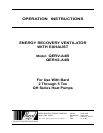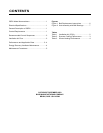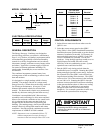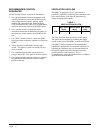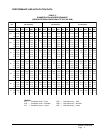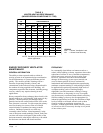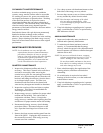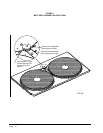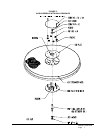
Manual 2100-310D
Page 5
CLEANABILITY AND PERFORMANCE
In order to maintain energy recovery ventilation
systems, energy transfer surfaces must be accessible
for washing to remove oils, grease, tars and dirt that
can impede performance or generate odors. Washing
of the desiccant surfaces is required to remove
contaminate buildups that can reduce adsorption of
water molecules. The continued ability of an enthalpy
wheel to transfer latent energy depends upon the
permanence of the bond between the desiccant and the
energy transfer surfaces.
Bard wheels feature silica gel desiccant permanently
bonded to the heat exchange surface without
adhesives; the desiccant will not be lost in the washing
process. Proper cleaning of the Bard energy recovery
wheel will restore latent effectiveness to near original
performance.
MAINTENANCE PROCEDURES
NOTE: Local conditions can vary and affect the
required time between routine maintenance
procedures, therefore all sites (or specific
units at a site) may not have the same schedule
to maintain acceptable performance. The
following timetables are recommended and
can be altered based on local experience.
QUARTERLY MAINTENANCE
1. Inspect mist eliminator/prefilter and clean if
necessary. This filter is located in the wall sleeve
and can be accessed by either removing the
exterior louver grille, the vent package from inside
the unit, or by disconnecting the unit from the wall
brackets, and rolling the unit away from the sleeve
on its integral wheel system. The filter is an
aluminum mesh filter and can be cleaned with
water and any detergent not harmful to aluminum.
2. Inspect the comfort air filter and clean or replace
as necessary. This filter is located behind the
front-hinged service door.
3. Inspect energy recovery ventilator for proper wheel
rotation and dirt buildup. This can be done in
conjunction with Item 2 above. Energize the
energy recovery ventilator after inspecting the filter
and observe for proper rotation and/or dirt buildup.
4. Recommended energy recovery wheel cleaning
procedures follow: Disconnect all power to the
unit. Open the front-hinged service door to the
unit.
5. Remove the front cassette retaining panel from the
front of the QERV. Unplug the amp connectors to
the cassette drive motor. Slide energy recovery
cassette out of the ventilator.
6. Use a shop vacuum with brush attachment to clean
both sides of the energy recovery wheels.
7. Reverse shop vacuum to use as a blower and blow
out any residual dry debris from the wheel.
NOTE: Discoloration and staining of the wheel
does not affect its performance. Only
excessive buildup of foreign material needs
to be removed.
8. If any belt chirping or squealing noise is present,
apply a small amount of LPS-1 or equivalent dry
film lubricant to the belt.
ANNUAL MAINTENANCE
1. Inspect and conduct the same procedures as
outlined under Quarterly Maintenance.
2. To maintain peak latent (moisture) removal
capacity, it is recommended that the energy
recovery wheels be sprayed with a diluted nonacid
based evaporator coil cleaner or alkaline detergent
solution such as 409.
NOTE: Do not use acid based cleaners, aromatic
solvents, temperatures in excess of 170°F or
steam. Damage to the wheel may result.
Do not disassemble and immerse the entire
heat wheel in a soaking solution, as bearing
and other damage may result.
3. Rinse wheel thoroughly after application of the
cleaning solution, and allow to drain before
reinstalling.
4. No re-lubrication is required to heat wheel
bearings of the drive motor, or to the intake and
exhaust blower motors.
5. If any belt chirping or squealing noise is present,
apply a small amount of LPS-1 or equivalent dry
film lubricant to the belt.



